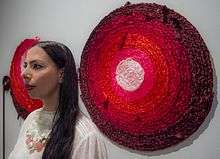Cristina Rodrigues
| Cristina Rodrigues | |
|---|---|
|
Cristina Rodrigues at her exhibition La Pasión, in Seville | |
| Born |
1 July 1980 Porto, Portugal |
| Education | University of Porto; Manchester School of Art |
| Notable work | The Blanket; Enlightenment |
Cristina Rodrigues (Porto, born 1 July 1980) is a Portuguese artist and architect. Her art work was the main feature and cover of 2016's January/February issue of the American magazine SCULPTURE, one of the world's most relevant publications on that field.
Life and career
The eclecticism which characterises her work can be traced back to her studies in Architecture, Medieval and Renaissance History and Contemporary Art. She graduated in Architecture (2014) and completed a Masters degree in Medieval and Renaissance History (2007) at the University of Porto, Portugal. Later she moved to Manchester, United Kingdom, where she lectured at university and was awarded a PhD in Art and Design at Manchester School of Art (2016).
In 2011 Cristina was awarded a research grant by the Arts and Humanities Research Council to develop her ongoing research project ‘Design for Desertification’. She then focused her research work on the study and register of Portuguese territories with low population density. She also began to create some of her most poignant contemporary art work, and textiles became her trade mark from the outset. The recurring use of satin ribbons, industrial fabrics and lace has been a distinguishing feature in her aesthetic narrative.
Manchester, the old textile capital of Europe, became her chosen home for seven years and during this time Cristina focused on the study of Contemporary Art. By combining her many interests, namely culture, oral traditions and textiles, she created The Blanket, one of her most emblematic works. The original version of this contemporary art installation was made with Idanha-a-Nova’s traditional instrument, the adufe, cotton lace and satin ribbons.
Themes
Cristina Rodrigues interprets reality by analyzing mentalities and iconographies in contemporary society. The dialectics between tradition and contemporaneity is central to her work.
Her art celebrates the role of women in contemporary society. Items which are characteristic of the female universe are used in her works of art. Cotton lace, satin ribbons, glass and crystal necklaces are combined with iron and musical instruments in order to build narratives. Ready-made necklaces bought in the pound shop are combined with luxurious china, in an eclectic blend creating an analogy with contemporary society.
Emigration, a theme which is particularly relevant to her generation, is addressed in some of her work, namely the sculpture Grapes of Wrath, inspired by John Steinbeck’s work. Herself a migrant, for several years Cristina collected furniture that had belonged to migrants from the various communities in Manchester, United Kingdom. The contemporary art installation titled Bourgeois comprises four chairs previously owned by an Iranian family living in Stockport, United Kingdom. Like these, several other conventional furnishing underwent an intervention by the artist, transforming them into luxury objects.
Works
In situ, Cristina’s art installations and sculptures adorne ordinary objects with baroque detail. She combines creative flair with everyday items. Each of her art installations is locally inspired yet universal in meaning, and it intentionally touches the lives of all those involved in its artistic production. Cristina’s practice is marked by simple aesthetics, almost always based on ethnographic research.
The patterns and stereotomies produced by the recurring satin ribbons are one of Cristina’s trademarks. However, with reference to narratives and artefacts that are familiar to her daily life, Cristina essentially uses popular materials, which relate to a woman’s condition and draws on crafting techniques usually associated to domestic crafts.
Exhibitions
With exhibitions since 2012, the following stand out:
- 2016
La Pasión, Seville, Spain. Distributed by 5 different locations: Fundación Valentín de Madariaga y Oya; Portuguese Pavilion; Universidad de Sevilla; Casa de la Província and Real Alcázar de Sevilla.
The Queen, São Gonçalo Church, Amarante, Portugal.
- 2015
Underlying Beauty, São Clemente Palace, Rio de Janeiro, Brazil.
Underlying Beauty, Municipal Museum Amadeo Souza-Cardoso, Amarante, Portugal.
The Fountain of Happiness, Tatton Park Gardens, Knutsford, United Kingdom.
Guardian Angels, Tatton Park Mansion, Knutsford, United Kingdom.
Heaven Descends To Earth, Alcobaça Monastery, Alcobaça, Portugal.
- 2014
Women From My Country, Manchester Cathedral, Manchester, United Kingdom.
The Moroccan House, The Consulate General of Portugal in Manchester, United Kingdom.
The House, Zweigstelle Gallery, Berlin, Germany.
- 2013
My Country Through Your Eyes, Jerónimos Monastery, Lisbon, Portugal.
DfD - Design for Desertification, CCR - Centro Cultural Raiano, Idanha-a-Nova, Portugal.
21st Century Rural Museum, MUDE - Museu do Design e da Moda, Lisbon, Portugal.
Issues of Urbanisation, Guangdong Museum of Art, Guangzhou, China.
- 2012
21st Century Rural Museum, Consulate General of Portugal in Manchester, United Kingdom.
Partnerships
During her artistic career Cristina Rodrigues worked in partnership with different public and private entities and some of the most significant Portuguese brands. Cristina has been working closely with the Porto lace mill - Fábrica de Rendas Portuense, - since 2011. This mill still produces cotton lace using original industrial revolution machinery, acquired from a mill in Leicester, United Kingdom. Recently, Cristina Rodrigues collaborated with other brands such as: Licor Beirão, the artist produced a large scale iron sculpture titled The Fountain of Happiness with Licor Beirão glass bottles; ICEL, a cutlery brand and the Portuguese shoes brand FLY London, wich inspired her art installation titled Urban Dwellers.
